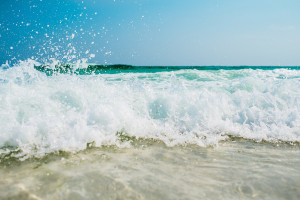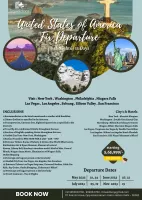Krang Suri Falls Travel Guide
Krang Suri Falls, located in the Jaintia Hills district of Meghalaya, India, is a breathtaking natural wonder that attracts visitors from all over the world. This hidden gem is renowned for its crystal-clear turquoise waters cascading down the lush green cliffs, creating a picturesque setting for visitors to enjoy. The region is rich in biodiversity and is a popular destination for nature lovers and adventure enthusiasts.Top Attractions in Krang Suri Falls
1. Krang Suri Falls 2. Dawki River 3. Mawlynnong Village 4. Living Root Bridges 5. Cherrapunji 6. Nohkalikai FallsKrang Suri Falls is Famous for
Its stunning turquoise waters and picturesque surroundings make Krang Suri Falls a must-visit destination for nature lovers and photographers.Top Attractions in Krang Suri Falls
- Krang Suri Falls - Dawki River - Mawlynnong Village - Living Root Bridges - Cherrapunji - Nohkalikai FallsWhat's Great about Travelling to Krang Suri Falls?
- Natural beauty - Adventure opportunities - Serene environmentWhat's Not So Great about Travelling to Krang Suri Falls?
- Limited accommodation options - Remote location - Limited dining choicesTravel Tips for Krang Suri Falls
- Ensure to carry insect repellent - Wear comfortable walking shoes - Respect local customs and traditionsImportant Krang Suri Falls trip information
- Ideal Duration: 2-3 days
- Best Time to Visit: October to May
- Nearby Airports and Railway Stations: Shillong Airport and Guwahati Railway Station
Per Person
67,529
*EXCLUDING APPLICABLE TAXES 4.9 Ratings
( 200 Reviews )
( 200 Reviews )
Per Person
5,65,999
*EXCLUDING APPLICABLE TAXES FAQ's on Krang Suri Falls
Q1: What is the best time to visit Krang Suri Falls?
The best time to visit Krang Suri Falls is during the dry season, which is typically from November to March. The weather is pleasant, and the water flow is at its peak during this time, making it ideal for swimming and enjoying the natural beauty of the falls. It is advisable to avoid the monsoon season (June to September) as the heavy rainfall can lead to dangerous water currents and limited visibility.
Q2: Do I need a visa to travel to Krang Suri Falls?
Travelers to Krang Suri Falls do not require a visa specifically for the falls as it is located in India. However, international travelers visiting India will need a valid tourist visa. It is important to check the visa requirements based on your nationality before planning your trip.
Q3: What are the must-visit attractions in Krang Suri Falls?
Apart from the spectacular Krang Suri Falls, visitors to this region should explore the stunning Dawki River, the picturesque Mawlynnong Village known as the cleanest village in Asia, and the living root bridges of Cherrapunji. Nature lovers can also visit the Nohkalikai Falls and the Seven Sisters Falls for breathtaking views of cascading water amidst lush greenery.
Q4: Is Krang Suri Falls a safe place to travel?
Krang Suri Falls is generally safe for tourists, but it is advisable to take necessary precautions like avoiding swimming in strong currents, following designated paths, and being mindful of slippery rocks around the falls. It is recommended to travel with a guide or local expert when exploring the area, especially if you are unfamiliar with the terrain.
Q5: What is the local currency in Krang Suri Falls and can I use credit cards?
The local currency in Krang Suri Falls is the Indian Rupee (INR). While credit cards are accepted at some hotels, restaurants, and larger establishments, it is advisable to carry cash for smaller vendors and local markets. ATMs are limited in the area, so it is recommended to withdraw cash in major towns before heading to Krang Suri Falls.
Q6: What is the local cuisine like in Krang Suri Falls?
The local cuisine in Krang Suri Falls and the surrounding regions is a delightful mix of flavors influenced by the indigenous Khasi and Jaintia tribes. Visitors can savor dishes like Jadoh (rice cooked with meat and spices), Dohneiiong (pork with black sesame), and Pukhlein (a sweet rice dessert). Vegetarian options like Tungrymbai (fermented soybean chutney) are also popular. Travelers with dietary restrictions should communicate their preferences to ensure a pleasant culinary experience.
Q7: What transportation options are available in Krang Suri Falls?
Transportation options in Krang Suri Falls include private taxis, shared cabs, and local buses. Hiring a taxi or cab is the most convenient way to reach the falls from nearby towns like Shillong or Cherrapunji. For a more adventurous experience, travelers can opt for local buses that operate on specific routes. It is recommended to book transportation in advance, especially during peak tourist seasons, to avoid any last-minute hassles.
Q8: Are there any cultural norms or etiquette I should be aware of when visiting Krang Suri Falls?
When visiting Krang Suri Falls and the surrounding areas, it is important to respect the local customs and traditions of the indigenous tribes. Dress modestly, especially when visiting religious sites or interacting with locals. Seek permission before taking photographs of people or private property. It is customary to greet people with a friendly "Khublei" (thank you) and be mindful of local sensitivities. Avoid littering and help in preserving the natural beauty of the region by following designated trails and waste disposal guidelines.
Q9: I am a travel agent. How can I buy travel leads of Krang Suri Falls?
Register yourself as a travel agent at agents.tripclap.com and then you can buy travel leads to Krang Suri Falls once your account is approved. For more details contact our support team at +91-8069186564 or support@tripclap.com


